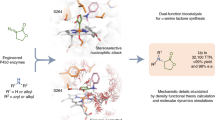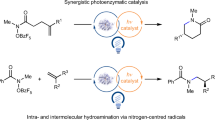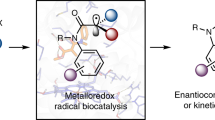Abstract
Selectively modified α- and β-cyclodextrin ketones or aldehydes act as artificial oxidases on a variety of small lipophilic substrates. The structure of the substrate is a highly important factor governing how effectively the oxidation reaction can be catalyzed. Amino acid-type substrates were not prone to catalysis, which yields new information about the limits of CD catalysis. Aniline showed some non-quantifiable catalysis, but for quinones and benzyl alcohols no net catalysis was detected. For aminophenol oxidation, o-aminophenols are far better substrates than p-aminophenols. The CD-catalyzed reaction follows Michaelis–Menten kinetics, involves CD cavity binding of the substrate and substrate recognition, and thus encompasses many of the hallmarks of natural enzymatic catalysis. Strong binding of the cooxidant H2O2 to the CD catalytic carbonyl group is a prerequisite for the subsequent oxidation of the substrate and in accordance with this, the binding of H2O2 to β-CD dialdehyde was shown to be strong (K d = 1.4 mM). β-CD 6A,6D-diketone which binds H2O2 weaker than an aldehyde was accordingly a less efficient oxidase. The wide range of substrates applicable to CD chemzyme catalysis brings about optimism for future scopes of synthetic biology.
Graphical Abstract









Similar content being viewed by others
Abbreviations
- CD:
-
Cyclodextrin
- K m :
-
Michaelis–Menten constant
- K d :
-
Dissociation constant
- k cat :
-
Catalyzed reaction rate
- k uncat :
-
Uncatalyzed reaction rate
References
Burton, S.G.: Laccases and phenol oxidases in organic synthesis—a review. Curr. Organ. Chem. 7, 1317–1331 (2003)
Ferguson Miller, S., Babcock, G.T.: Heme/copper terminal oxidases. Chem. Rev. 96, 2889–2907 (1996)
Bjerre, J., Rousseau, C., Marinescu, L., Bols, M.: Artificial enzymes, “chemzymes”: current state and perspectives. Appl. Microbiol. Biotechnol. 81, 1–11 (2008)
Zhang, B., Breslow, R.: Ester hydrolysis by a catalytic cyclodextrin dimer enzyme mimic with a metallobipyridyl linking group. J. Am. Chem. Soc. 119, 1676–1681 (1997)
Yan, J., Breslow, R.: An enzyme mimic that hydrolyzes an unactivated ester with catalytic turnover. Tetrahedron Lett. 41, 2059–2062 (2000)
Tsutsumi, H., Ikeda, H., Mihara, H., Ueno, A.: Enantioselective ester hydrolysis catalyzed by β-cyclodextrin conjugated with β-hairpin peptides. Bioorg. Med. Chem. Lett. 14, 723–726 (2004)
Ye, H., Tong, W., D’Souza, V.T.: Efficient catalysis of a redox reaction by an artificial enzyme. J. Am. Chem. Soc. 114, 5470–5472 (1992)
Ye, H., Rong, D., Tong, W., D’Souza, V.T.: Artificial redox enzymes. Part 3: structure and properties. J. Chem. Soc. Perkin Trans. 2, 2071–2076 (1992)
Ye, H., Tong, W., D’Souza, V.T.: Flavocyclodextrins as artificial redox enzymes. Part 4: catalytic reactions of alcohols, aldehydes and thiols. J. Chem. Soc. Perkin Trans. 2, 2431–2437 (1994)
Breslow, R., Dong, S.D.: Biomimetic reactions catalyzed by cyclodextrins and their derivatives. Chem. Rev. 98, 1997–2011 (1998)
Bjerre, J., Nielsen, E.H., Bols, M.: Hydrolysis of toxic natural glucosides catalyzed by cyclodextrin dicyanohydrins. Eur. J. Org. Chem. 745–752 (2008)
Ortega-Caballero, F., Bjerre, J., Laustsen, L.S., Bols, M.: Four orders of magnitude rate increase in artificial enzyme-catalyzed aryl glycoside hydrolysis. J. Org. Chem 70, 7217–7226 (2005)
Fenger, T.H., Bjerre, J., Bols, M.: Cyclodextrin aldehydes are oxidase mimics. ChemBioChem 10, 2494–2503 (2009)
Filliben, J.J.: Dataplot—an interactive high-level language for graphics, non-linear fitting, data analysis and mathematics. Comput. Graph. 15, 199–213 (1981)
Bjerre, J., Fenger, T.H., Bols, M.: Synthesis of some trifluoromethylated cyclodextrin derivatives and analysis of their properties as artificial glycosidases and oxidases. Eur. J. Org. Chem. 704–710 (2007)
Pearce, A., Sinaÿ, P.: Diisobutylaluminium-promoted regioselective de-O-benzylation of perbenzylated cyclodextrins: a powerful new strategy for the preparation of selectively modified cyclodextrins. Angew. Chem. Int. Ed. 39, 3610–3612 (2000)
Lecourt, T., Herault, A.J., Pearce, M., Sollogoub, M., Sinaÿ, P.: Triisobutylaluminium and diisobutylaluminium hydride as molecular scalpels: the regioselective stripping of perbenzylated sugars and cyclodextrins. Chem. Eur. J. 10, 2960–2971 (2004)
Lecourt, T., Mallet, J.-M., Sinaÿ, P.: An efficient preparation of 6I, IV dihydroxy permethylated β-cyclodextrin. Carbohydr. Res. 338, 2417–2419 (2003)
Horvath, T., Kaizer, J., Speier, G.: Functional phenoxazinone synthase models. Kinetic studies on the copper-catalyzed oxygenation of 2-aminophenol. J. Mol. Catal. 215, 9–15 (2004)
Brown, K.C., Corbett, J.F.: Benzoquinone imines. Part 16. Oxidation of p-aminophenol in aqueous solution. J. Chem. Soc. Perkin Trans. 2, 308–311 (1979)
Fenger, T.H., Marinescu, L.G., Bols, M.: Cyclodextrin ketones as oxidation catalysts: investigation of bridged derivatives. Org. Biomol. Chem. 7, 933–943 (2009)
Marinescu, L., Bols, M.: Very high rate enhancement of benzyl alcohol oxidation by an artificial enzyme. Angew. Chem. Int. Ed. 45, 4590–4593 (2006)
Suzuki, H., Furusho, Y., Higashi, T., Ohnishi, Y., Horinouchi, S.: A novel o-aminophenol oxidase responsible for formation of the phenoxazinone chromophore of grixazone. J. Biol. Chem. 281, 824–833 (2006)
Marinescu, L., Mølbach, M., Rousseau, C., Bols, M.: Supramolecular oxidation of anilines using hydrogen peroxide as stoichiometric oxidant. J. Am. Chem. Soc. 127, 17578–17579 (2005)
Sander, E.G., Jencks, W.P.: Equilibria for additions to the carbonyl group. J. Am. Chem. Soc. 90, 6154–6162 (1968)
Rousseau, C.; Christensen, B.; Bols, M.: Artificial epoxidase II. Synthesis of cyclodextrin ketoesters and epoxidation of alkenes. Eur. J. Org. Chem. 2734–2739 (2005)
Rousseau, C., Christensen, B., Petersen, T.E., Bols, M.: Cyclodextrins containing an acetone bridge. Synthesis and study as epoxidation catalysts. Org. Biomol. Chem. 2, 3476–3482 (2004)
Travis, B.R., Sivakumar, M., Hollist, G.O., Borhan, B.: Facile oxidation of aldehydes to acids and esters with oxone. Org. Lett. 5, 1031–1034 (2003)
Acknowledgments
We thank The Lundbeck Foundation for financial support.
Author information
Authors and Affiliations
Corresponding author
Additional information
This work was presented at the First European Cyclodextrin Conference, Aalborg, Denmark, 11–13th of October 2009.
Rights and permissions
About this article
Cite this article
Bjerre, J., Bols, M. Substrate structure governs maximum rate of catalysis exerted by cyclodextrin oxidase chemzymes. J Incl Phenom Macrocycl Chem 69, 417–423 (2011). https://doi.org/10.1007/s10847-010-9774-8
Received:
Accepted:
Published:
Issue Date:
DOI: https://doi.org/10.1007/s10847-010-9774-8




